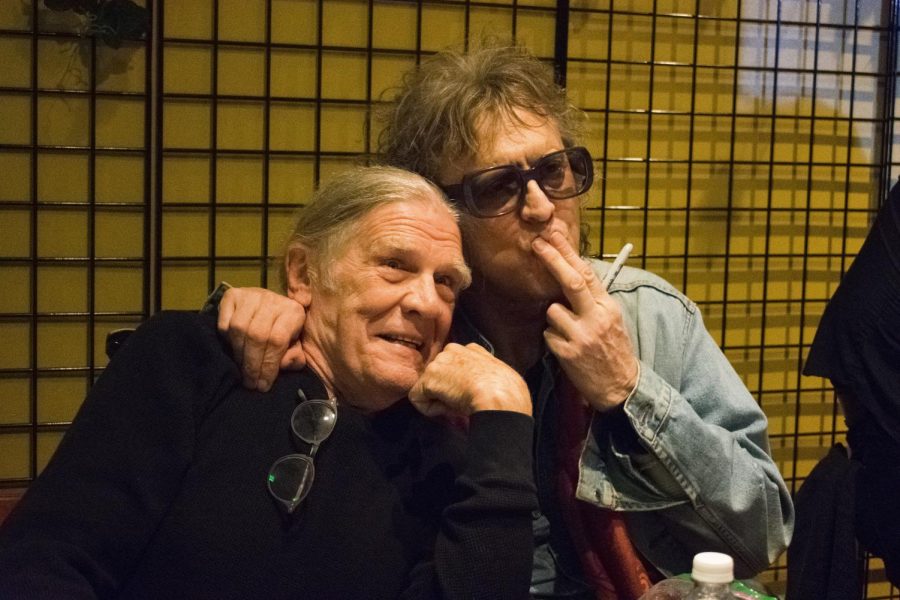Mick Rock and Henry Diltz: Two unconnected stories of capturing and becoming legends
Henry Diltz, left, and Mick Rock, right, pose together at an exhibition celebrating their groundbreaking work in music photography.
October 9, 2019
Behind the album covers of almost every rock ’n’ roll music legend lies two men — one from London and one from California — each of whom stumbled upon photography in their 20s and ultimately became legends themselves. Mick Rock and Henry Diltz led parallel lives down the path of music photography, defining the most influential icons in music since the 1970s.
Rock, now known as “The Man Who Shot the ’70s,” captured the true spirit of rock ’n’ roll through his dramatic and theatrical images of artists ranging from Freddie Mercury to Lenny Kravitz, Snoop Dogg and Pharrell in the present day. Meanwhile, Diltz mainly acted as a fly on the wall, capturing the faces and essence that represented the folk and rock music scenes throughout the ’60s and ’70s.
“Photographing all my heroes and hanging out with the people I photographed,” Diltz said. “That was the best part.”
As a psychology major at the University of Hawaii and a former musician himself, Diltz was very interested in people, especially other musicians, and their behavior, which he translated through the candids he took of those around him. He had close connections with other artists, such as Stephen Stills and Mama Cass, which ultimately led to photo shoots with his idols, including Jackson Browne, Paul McCartney and the Eagles. Diltz believes his understanding of musicians and their lifestyle enabled him to capture their true natures.
“Musicians know how to hang out,” he said.
While he initially did not think of himself as a photographer, Diltz eventually fell into the art, beginning his career with a simple picture of a mural with five men posing in front of it. Unexpectedly, TeenSet magazine called him, asking for the picture of the men — who happened to be the famous band Buffalo Springfield. That became his first published rock ’n’ roll photograph.
Since that moment, Diltz has followed musicians on tour worldwide to learn more about documentary photography, whether in the Virgin Islands with the Beatles or in New Zealand with David Cassidy. Throughout his near-55 years as a photographer, Diltz has captured images for hundreds of album covers and photographed a multitude of festivals. He even became the official photographer of Woodstock in 1969.
Rock’s early rise in photography consisted of shooting Pink Floyd’s frontman Syd Barrett and Irish blues guitarist Rory Gallagher. But his career hit a turning point when he created David Bowie’s album cover for Hunky Dory, which became the start of a lifelong friendship. Soon enough, Rock’s name would soar after the “infamous guitar fellatio shot” in the summer of 1972, which captured a racy image of Bowie, known by his alter ego Ziggy Stardust at the time, licking Mick Ronson’s electric guitar strings at a concert in Oxford Town Hall.
“That was something for people to remember,” he said.
Next came a continuous string of album covers for music icons, including Iggy Pop, Lou Reed and Queen. Along with his famed images of nearly every rock ‘n’ roll genius, Rock has also photographed fashion models, kabuki actors and even his two beloved cats. Despite his interest in other types of photography, he credits the musicians, as well as fate, for the career path he has chosen.
“If it hadn’t been for musicians, I almost certainly wouldn’t have been a photographer,” Rock said. “I related to the musicians, and I kind of looked like one of them, so that helped as well. And I had this silly name, so somehow, it was all written a long time ago. I do believe that everybody has a destiny, but not everybody embraces it.”
Before their fame, Rock and Diltz each began as photography hobbyists, taking pictures of friends for fun, as being a photographer was “a fairly daft idea at the time,” Rock said. The two found their passions for photography accidentally, with Rock randomly picking up a friend’s camera and Diltz impulsively buying one in an antique store.
“At some point — when I was very high — I picked up his camera and started to play with it,” Rock said. “There was a young lady with me, and I kept pointing the camera at her and clicking away. It enhanced everything. Whatever I saw, there was more.”
Diltz walked into an antique shop while on tour in 1966 with his group, the Modern Folk Quartet. One of his friends grabbed a second-hand slide film camera off a table, and Diltz instinctively followed. After taking candids of their experiences traveling around Los Angeles, the group projected a compilation of all the pictures they took and found themselves wonderstruck.
“Now, that was magic,” Diltz said, recalling his utter awe at the eight-foot wide slideshow.
Currently, Rock and Diltz are on their first East Coast tour together, which began Monday at City Winery in Boston. The tour is presented by the Morrison Hotel Gallery, which is co-owned by Diltz and represents 125 photographers, including Rock. The “Behind the Lens” series of photography shows features their greatest pictures as the two tell the unbelievable stories behind each image.
“Being a photographer is like having a passport to people’s lives,” Diltz said during the show.
Rock and Diltz have ultimately become key figures in strengthening the presence of rock ’n’ roll throughout the country, long before the photography industry was understood and appreciated.
“Since I have a degree from Cambridge, [my mother] thought I should be doing something more sensible,” Rock said, laughing. “I remember her saying to me, ‘I know you’re only doing this, Michael, to avoid getting a real job.’ And I clearly remember thinking, ‘Yes, mother. That’s exactly what I was doing.’”
Having been the only photographer at The Doors’ live concert at the Hollywood Bowl in July 1968 — an event that would have hosted numerous photographers nowadays — Diltz saw interest in photography grow firsthand throughout the decades. With growing technology and respect for the art, both photographers have come to realize the sudden ease it takes for anyone to become a photographer.
“Back in the early ’70s, everybody I knew wanted to be a guitar player,” Rock said. “Now, everyone wants to be a photographer, which you can be. Everybody can be, and I love it.”


















